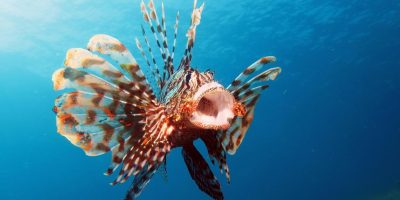BY: ASHLEY AUERBACH, UW UNDERGRADUATE STUDENT MAJORING IN BIOLOGY
With increasing human populations there is also an increased demand for fish. From 1990 to 1997 fish consumption increased 31% but the supply of marine fisheries grew by only 9% (Muir 2004). Expanding aquaculture production has the potential to meet the demand for fish, while also protecting marine fish stocks from overexploitation. The development of genetically engineered fish can increase the yield of fish farms and reduce pressures on ocean fisheries. This can help to bridge the gap between fish supply and demand, in order to feed the expected human population of 9.6 billion people on the planet by 2050 (Muir 2004).
Genetically engineered fish may seem like a thing of the future, but it is already being sold to the public. United States firm, AquaBounty, has already sold approximately 5 tons of genetically engineered salmon fillets to customers in Canada. This is historically significant, as it marks the first time that a genetically engineered animal has been sold for human consumption on the open market. AquaBounty engineered Atlantic salmon (Salmo salar) with a growth-hormone gene from another salmon species, Chinook salmon (Oncorhynchus tshawytscha). Genetic regulatory elements were also added from Ocean pout (Zoarces americanus). These genetic changes allow the Atlantic salmon to grow much faster than normal. They can reach market size in 18 months, about half the time needed for non-genetically engineered Atlantic salmon to grow to the same size.

Fisherman holding the genetically engineered AquaBounty salmon in comparison to non-engineered salmon. Note the size difference: the genetically engineered salmon of the same age is much larger in size. (Source: Paul Darrow/NYT/Redux/eyevine)
The United States Food and Drug Administration (FDA) has determined that AquaBounty Salmon are safe to eat, the genes introduced are safe for the fish, and the faster growth claims are accurate. The FDA also completed testing to compare key hormone levels between genetically engineered and non-genetically engineered fish. There were no biologically relevant differences in estradiol, testosterone, or other hormone levels between the fish. Also, there was no significant difference in the nutritional profile of the compared fish. Compliance with the National Environmental Policy Act (NEPA) led the FDA to also investigate environmental effects of AquaBounty Salmon. The FDA found the fish to cause no significant impact on the environment of the United States. Overall, the FDA has decided that this type of salmon is safe for human consumption and has no significant impact on the environment.
Regardless of FDA findings, there has been public scrutiny and mistrust in the safety of genetically engineered fish. If these genetically modified fish were released into the wild, it could cause great ecological changes. The AquaBounty Salmon could outcompete local fish populations, as they can grow faster and use nutrients more efficiently. This could cause changes in predator-prey relationships and changes in ecological niches (Muir 2004). If the genetically engineered fish mated with wild fish, the new genes could be spread to the wild population. The ecological impacts can be prevented as long as the genetically engineered fish are well contained, so that the fish or their eggs do not escape into the wild.
William M Muir, a professor of Animal Sciences at Purdue University, argues that a “generally accepted model for assessing the environmental risk of genetically engineered organisms would not only help regulators but also address fears about this technology.” More research is needed to determine the effects of genetically engineered fish release into the ocean.
Another contentious issue is the labelling of genetically engineered foods. Prior to the approval of AquaBounty Salmon, the FDA received over 300,000 public comments. Many members of the public showed concern over the labelling of genetically engineered fish. However, the FDA concluded that no additional labelling is necessary, arguing that “AquAdvantage Salmon is not materially different from food derived from other Atlantic salmon.”
Greater transparency between fish producers and consumers through the introduction of honest labelling would be beneficial in improving public opinion of genetically engineered fish. The FDA should implement honest labelling of genetically engineered food products. This would allow consumers to be knowledgeable about the source and, potentially, the genetic composition of the fish they are buying.
There should also be a greater investment into research on the ecological effects of genetically engineered fish. This would allow scientists to better understand the possible effects of genetically engineered fish species released into the ocean, so that broad ecosystem changes can be avoided. With more information and greater public knowledge, developments can be made that increase food supply and food security for the increasing human population.
Sources: Greenberg, Paul. “Genetically Engineered Fish and the Strangeness of American Salmon.” The New Yorker, 2 Dec. 2015, www.newyorker.com/business/currency/genetically-engineered-fish-and-the-strangeness-of-american-salmon. Maxmen, Amy. “FDA Backs Safety of Transgenic Fish.” Scientific American, Nature Magazine, 23 Dec. 2012, www.scientificamerican.com/article/transgenic-fish-wins-regulatory/. Medicine, Center for Veterinary. “Genetically Engineered Animals - AquAdvantage Salmon Fact Sheet.” U S Food and Drug Administration Home Page, Center for Veterinary Medicine, www.fda.gov/AnimalVeterinary/DevelopmentApprovalProcess/GeneticEngineering/GeneticallyEngineeredAnimals/ucm473238.htm. Muir, William M. “The Threats and Benefits of GM Fish.” EMBO Reports, U.S. National Library of Medicine, July 2004, www.ncbi.nlm.nih.gov/pmc/articles/PMC1299107/. Reid, David. “Salmon Becomes World’s First Genetically-Modified Animal to Enter Food Supply.” CNBC, 9 Aug. 2017, www.cnbc.com/2017/08/09/salmon-becomes-worlds-first-genetically-modified-animal-to-enter-food-supply.html. Waltz, Emily. “First Genetically Engineered Salmon Sold in Canada.” Nature News, Nature Publishing Group, 4 Aug. 2017, www.nature.com/news/first-genetically-engineered-salmon-sold-in-canada-1.22116.






Leave a Reply